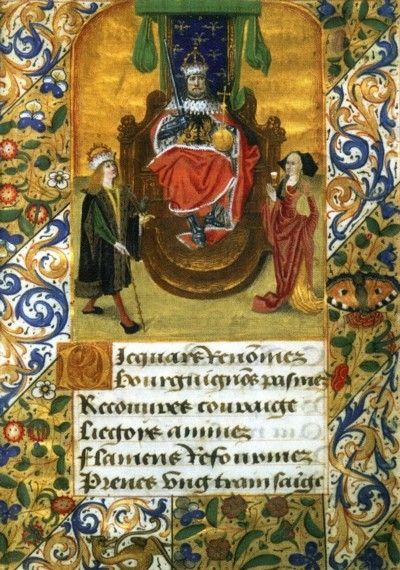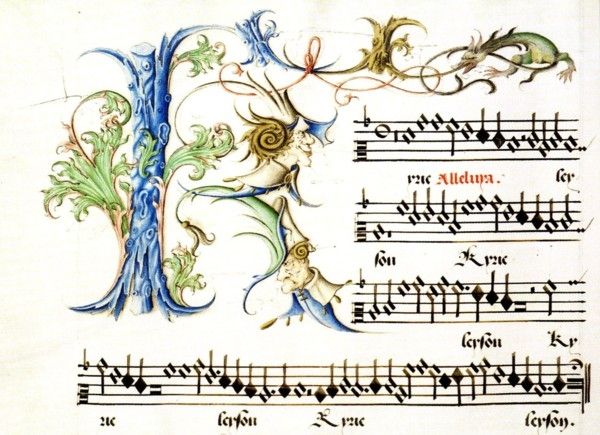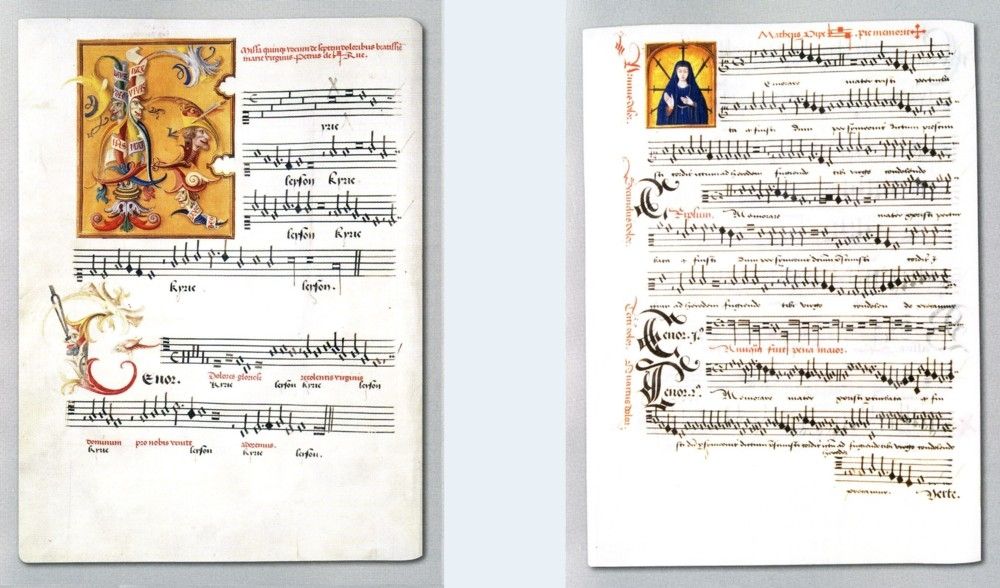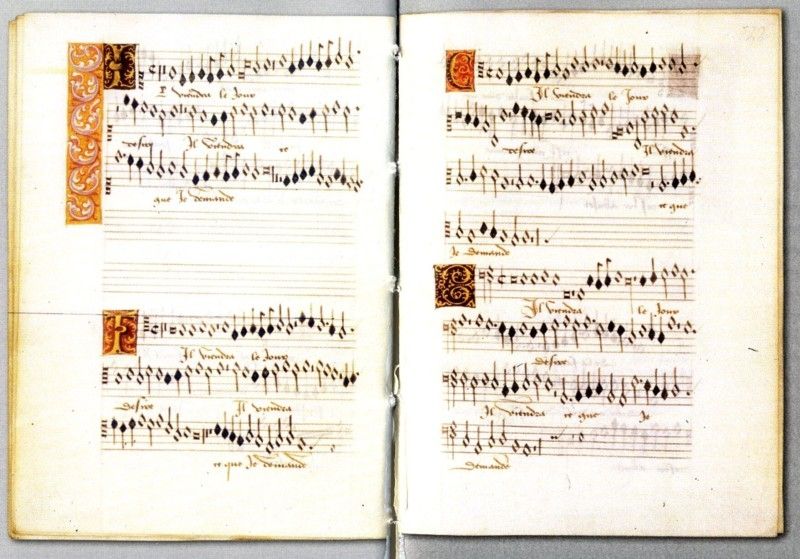
PIERRE DE LA RUE
One of the most significant and prolific composers of his generation,
Pierre de la Rue was almost certainly born in Tournai, a city ruled by
France in the fifteenth century - and chief town of the current Belgian
province of Hainaut. His birth-date and education are unknown, but the
latter is very likely to have been in the maîtrise of the city's
important cathedral. As with so many composers of the time, we know
little of his early employment (since La Rue sang the highest vocal
part, he is unlikely to be the tenorist Peter vander Straten, as
formerly thought). In his early years he probably worked at the church
of Sint Odenrode in the town of the same name (in the current Dutch
Brabant, near 's-Hertogenbosch), but by 1492 he was employed in the
chapel of Maximilian, the future Holy Roman Emperor, widower of Mary of
Burgundy, and father of Philip the Fair and Margaret of Austria, each
of whom would eventually include La Rue among their musicians
[Illustration 1].

The Habsburg-Burgundian court was a key political player on the world
stage, and it was equally important as a major musical center as well,
with a very large collection of permanent chapel members who performed
an impressive daily series of musical services for its ruler: a daily
polyphonic mass and daily Vespers and Compline services, both of which
incorporated polyphony as well. On major feast days, and during Advent
and Lent, this round of musical activities was expanded still further.
La Rue thus had a ready outlet for his compositions, which grew to
include almost forty masses and individual mass movements, almost two
dozen motets, a complete series of eight Magnificats, and, for
non-liturgical entertainment, more than forty secular works. He also
had an impressive côterie of colleagues in the court chapel,
including such luminaries as Gaspar van Weerbeke, Alexander Agricola,
Nicolas Champion, Marbrianus de Orto, and Antonius Divitis. Yet La Rue
outshone them all in the quantity, quality, and variety of pieces he
wrote for the court. His compositions were the foundation as well for
another by-product of courtly splendor: a series of more than sixty
music manuscripts, some richly illuminated, that were generated by
scribes connected with the court and then given to royal patrons and
wealthy individuals across Europe. These manuscripts contain almost all
of La Rue's compositions.
By necessity, the court was a peripatetic one: rulers needed to show
their face to their subjects, and musical ceremony was a necessity for
the trappings of power. Habsburg-Burgundy was an especially wide-flung
realm, a good portion of which La Rue visited over the years of his
service. Under Maximilian he saw much of German-speaking lands; when
Philip the Fair came of age the court chapel returned to the Low
Countries and constantly moved about there. By 1501 Philip's wife Juana
was heiress to her homeland of Castile, and the court made an extended
trip to see what were to be her (or rather Philip's) future domains,
crossing through France, residing for months in Spain, and returning
slowly back through Habsburg territory.
In 1504 Isabella of Castile died, and in early 1506 Philip and his
massive retinue departed for Spain to lay claim to Castile. This time
they went by sea, but terrible storms forced them to land in England
and remain for months as guests of Henry VII. Less than half a year
after finally reaching Spain, Philip died, plunging the court into
confusion. La Rue and numerous chapel members remained in Spain,
serving Juana in her incessant mourning for her lost husband, and only
returning north in 1508.
On Philip's death, the new ruler of Habsburg-Burgundy was, in theory,
his six-year-old son, the archduke Charles. In practice, Charles's aunt
(and Philip's sister) Margaret of Austria governed the Low Countries
until Charles was declared of age in 1514. During this time the court
was, for the most part, resident in either Malines or Brussels, a
period of stability that seems to have facilitated La Rue's
compositional work. Then from 1514 to 1516 the court was on the move
again, as Charles toured the territories now under his direct rule. It
is likely that his plans for a trip to Spain, of which he became King
after the death of Ferdinand of Aragon, prompted La Rue's decision to
retire to Courtrai, where he owned a prebend, in 1516. He lived there
until his death on 20 November 1518.
The works recorded here form a rich sampling of his output from
different times in his career, many Marian in theme: four masses, five
motets, a Magnificat, and three chansons. Each offers an exploration of
a different musical challenge, and together they demonstrate the ways
in which La Rue was a leader in the expanding musical world of the late
fifteenth and early sixteenth centuries via his expansion of texture,
expansion of range, expansion of chromatic language, expansion of
formal possibilities, and expansion in the ways to use borrowed
material. May these recordings offer expanded joys to the listener as
well!
Masses
The Missa Sub tuum præsidium comes from La Rue's
earliest group of masses, appearing for the first time in the luxurious
manuscript copied for Philip the Fair before his final trip to Spain
(Brussels, Royal Library, Ms. 9126), where its prominent position as
the first La Rue mass in the collection, immediately after the opening
work by Josquin, suggests that it is a brand-new work. It ultimately
proved to be a highly popular one, appearing in whole or in part in
manuscripts and prints right up into the 1590s.
The work displays numerous structural characteristics typical of La
Rue's early works, with its four-voice texture, somewhat shorter
length, and standard layout for its movements with the exception of the
Sanctus. That movement has a separate Osanna II section, a rarity among
La Rue's masses. The mass is based on the well-known Marian antiphon,
but in phrygian rather than mixolydian, and imitated in all voices. La
Rue's penchant for continual variation of his motives is on full
display here, with a special emphasis on an exploration of rhythmic
mutability that makes this an especially captivating work.
Missa Ave Maria surely comes from the time after La Rue
returned from Spain in 1508, and is quite possibly from early in his
last period of composition. It is a substantial mass, as many of his
from this time are, with an emphasis now on duple rather than triple
meter. Four of the movements are for four voices, but the Credo expands
to five - an unusual move for the composer - and La Rue takes advantage
of this increase in texture to place the cantus firmus in the added
tenor voice, usually in longer note values. Such treatment is, again,
atypical for La Rue. Far more common is his integration of the chant
model into all voices so that it is indistinguishable from the
surrounding texture, as happens clearly at the beginning of all other
movements. The model is a Marian antiphon for the Feast of the
Annunciation, Ave Maria... benedicta tu, a version of which is
performed here before La Rue's mass. The joyful occasion celebrated in
the mass is perhaps the reason behind the relatively high ranges used
throughout this popular and widely-disseminated composition, which was
still being written about in the early seventeenth century.

Missa Alleluia [Illustration 2] is notable for several
features. Its texture is unusually full. The use of five voices is
common enough for La Rue - he is one of the most important composers in
terms of textural expansion - but most of the time in this mass four,
and often five, of the voices are employed, making it one of his most
richly-textured works. Even more striking is his use of pre-existent
material. The "alleluia" model has yet to be identified but is quite
likely extracted from a polyphonic composition. The manuscripts
containing the Missa Alleluia frequently underlay not the mass
text for the cantus firmus, but rather the word "alleluia," and the
recording incorporates that separate text into the performance. Placed
in the tenor line in long note values, typically entering the texture
last, the cantus firmus is treated by La Rue with a strictness that is
highly unusual for him, presented in augmentation, diminution, and even
retrograde (in the Qui tollis). La Rue typically writes the
cantus firmus in standard note values and provides instructions for the
performer; thus, in the Kyrie, "In duplo" tells the performers to
double the note values, while "Vade retro sathanas" (get thee hence,
Satan), tells the performers to sing the model backwards in the Qui
tollis. But the most striking appearance is saved for the final
Agnus, where the model migrates to the highest voice. Supported by a
swirling counterpoint of tightly constructed melodic motives in the
lower voices, the sustained melodic line calls to mind the closing of
Josquin's Missa L'homme armé super voces musicales, a
composition that La Rue knew and consciously emulated elsewhere as well.

The Missa de septem doloribus [Illustrations 3-4] is a
mature mass of La Rue, written for the Feast of the Seven Sorrows of
the Blessed Virgin Mary. The feast was created in 1423 and
enthusiastically supported by the Habsburg-Burgundian court during the
composer's tenure there, making it an appropriate subject for a mass.
La Rue's five-voice composition, performed here with plainchant propers
inserted, is noteworthy for its inclusion of a copious amount of extra
text, the words of its unidentified musical models. Whereas the Missa
Alleluia inserted the word "Alleluia" at various points in the
tenor line, the Missa de septem doloribus gives the tenor a
constant stream of new text in addition to that of the mass ordinary.
The first Kyrie gives the text for the invitatory for the feast day's
Matins ("Dolores gloriose"), while the Christe provides an unidentified
text beginning "Trenosa cornpassio." Starting with the second Kyrie,
the first tenor in most of the rest of the mass receives the lengthy
text of the feast's sequence. Whether these extra texts are performed
or not - the Mass ordinary text is sometimes absent from the cantus
firmus voice in the manuscripts, suggesting that the extra text was
intended to be heard - the performers and the owners of the luxurious
sources would have read and absorbed the new words that underscored the
subject of the feast.

The mass has another striking borrowing in its second Osanna
[Illustration 5]. The presence of a second Osanna is a rarity for La
Rue, and this one is extraordinarily short, a mere twelve breves. The
length was prompted by its borrowed material: the superius phrase "O
mater Dei, memento mei. Amen" from the conclusion of Josquin's famous Ave
Maria... virgo serena. Transposed down a twelfth and buried in La
Rue's first tenor part, the melody is nonetheless audible to those in
the know, and in all but one of the manuscript sources the tune is
provided with the borrowed words as well. In Brussels, Royal Library,
Ms. 6428, it stands out even more by virtue of the empty parchment
surrounding the first tenor part.
Motets and Magnificat
In Ave regina cœlorum La Rue sets the text of one
of the most important Marian antiphons, yet it is difficult to find any
melodic relation in his composition to the famous melody, or for that
matter to any other known plainchant. The work is still an
extraordinarily attractive composition and likely a late work, with its
modern-sounding modality, clear points of imitation, textural variety,
and concise expression of the text. Today's listeners are not the only
ones to succumb to its charms: it was one of the most popular of La
Rue's motets in the sixteenth century.
La Rue's setting of the popular Marian antiphon Regina cœli
survives in a single Italian source. The chant model is placed in the
tenor, on F, though the signature flat expected for this melody has
been erased in the manuscript. The remaining three voices present a
modal contrast, positioned in phrygian. La Rue solves this aural
conflict by having the tenor voice drop out before the end of each
section of this bipartite work, leaving the remaining three voices to
cadence safely on E. This procedure is unusual but not unknown for the
time, with the most famous example being, yet again, Josquin's Missa
L'homme armé super voces musicales.
La Rue's six settings of the Salve regina text make him the
most prolific composer to set this important antiphon. It is the Marian
antiphon to appear most frequently in the liturgical rotation, and was
highlighted through the numerous Salve (or "Lof") services held across
the Low Countries. As with his other settings, Salve regina II
is based on the Marian antiphon, its motives scattered throughout the
texture but appearing most prominently in the tenor, where its
treatment varies from strict to free, from long held notes to rapidly
flowing movement. The varied imitation and motivic interplay among the
voices is quintessential La Rue.
The massive motet Salve mater salvatoris - 300 breves
long - sets a prayer for the Assumption of the Blessed Virgin Mary that
has been lightly altered. The text would have had special meaning for
Margaret of Austria in her capacity as Governor of the Netherlands,
incorporating as it does the words "gubernatrix" and "Margarita." The
work is one of La Rue's many explorations of low ranges, with the top
voice using the alto clef and the lowest of the four given with an F5
clef and descending to D below the staff. Textural variety is
maintained through frequent use of duos as well as care in setting off
specific words or phrases, such as the rapid-fire exchange between high
and low pairs for "Tu Domina / angelorum / Tu Regina / seniorum / Tu
mamilla / parvulorum" (given additional emphasis through a short
excursion into triple meter) and especially the repeat of the word
"Margarita" to begin a new duet section, ensuring that La Rue's patron
would not miss his musical homage to her.
La Rue was one of the first composers to produce a complete Magnificat
cycle on all eight tones; seven of these survive. In each instance he
sets the even-numbered verses polyphonically, with the odd ones
performed in plainchant. Magnificat Quinti toni is a
typically gem-like setting, with reduced voices for verses 4, 8, and
10, and lively imitative counterpoint throughout, building to a
triple-meter conclusion.
Doleo super te is the quarta pars of La Rue's
lengthy Considera Israel, a motet almost certainly written for
Margaret on the death of her brother. This final section circulated on
its own in two sources, one of them - significantly - Margaret's
personal chansonnier, Brussels, Royal Library, Ms. 228. The full motet
sets David's lament for Jonathan from II Samuel; Doleo super te
opens with the text "I am distressed for thee, my brother Jonathan,"
and is thus a fitting component of Margaret's chansonnier, produced
after his death. This stunningly beautiful composition begins with
slowly-moving rhythms staggered among the four voices, and little
melodic motion to disturb the opening plaint. The piece continues with
a masterful command of shifting textures, with now one voice and then
another coming into focus, as for example when the superius sings
"unicum filium" in syncopation against the lower voices. All parts come
together only at "et perierunt arma" the approach to the conclusion,
and then one after another each voice descends by line or by leap, with
poignant falling thirds in the superius and then the bassus to generate
an ending that is no true cadence, but simply a cessation of sound.
Chansons

Pourquoy tant and Il viendra le jour
désiré [Illustration 7] were evidently intended
as a pair; they circulate one after another in their two manuscript
sources (Pourquoy tant also appears independently in Petrucci's Canti
C), and Il viendra provides an affirmative answer to the
despairing cry of Pourquoy tant. They share many stylistic
traits as well: each for four equal voices, each with similar (though
not exact) ranges, each modally based on A, each with a
(non-fixed-form) text of four lines with internal repetition, each
sharing a recurring bassus motive, each largely melismatic despite
repeated text, and each demonstrating La Rue's commitment to varietas.
Paired chansons become prominent later in the sixteenth century; La
Rue's duo serves as an important forerunner to this trend.
Pourquoy non [Illustration 8] is one of La Rue's most
impressive secular works. In keeping with the text's unhappy
sentiments, the four voices are pitched extremely low - the highest
note is only the G above middle C (the superius is written in tenor
clef!), while the lowest voice sinks to B-flat below the staff. La Rue
creates a powerful rhetorical structure for his text, with the mirrored
words of the first two lines - especially "Pourquoy non" - reflected in
almost exact musical repetition. Each of the first four phrases is
arrested by a fermata before continuing, an unheard-of beginning for a
chanson. The effect of the expanded range and the unusual formal
structure is heightened by the exploration of rarely-used accidentals.
All voices have both B-flats and E-flats in the signatures (one of the
very earliest works to have both accidentals in all voices), and the
altus, the voice that begins the composition all alone, leaps to a
signed A-flat on only its second note. Yet La Rue doesn't stop there
but goes still further: on the text "la fin" he extends the chromatic
range still further, reaching to D-flat. Range, layout, and harmony all
interact to generate a powerful setting of a despairing cry. It was one
of La Rue's most widely disseminated works (though often transposed up
a fifth, including its appearance in Odhecaton), and in
Margaret's chansonnier it is one of the few pieces to receive the
distinction of an illuminated border, a sure sign of its leading
position within La Rue's output. The song provides a concise summary of
his most powerful effects.
Honey MECONI